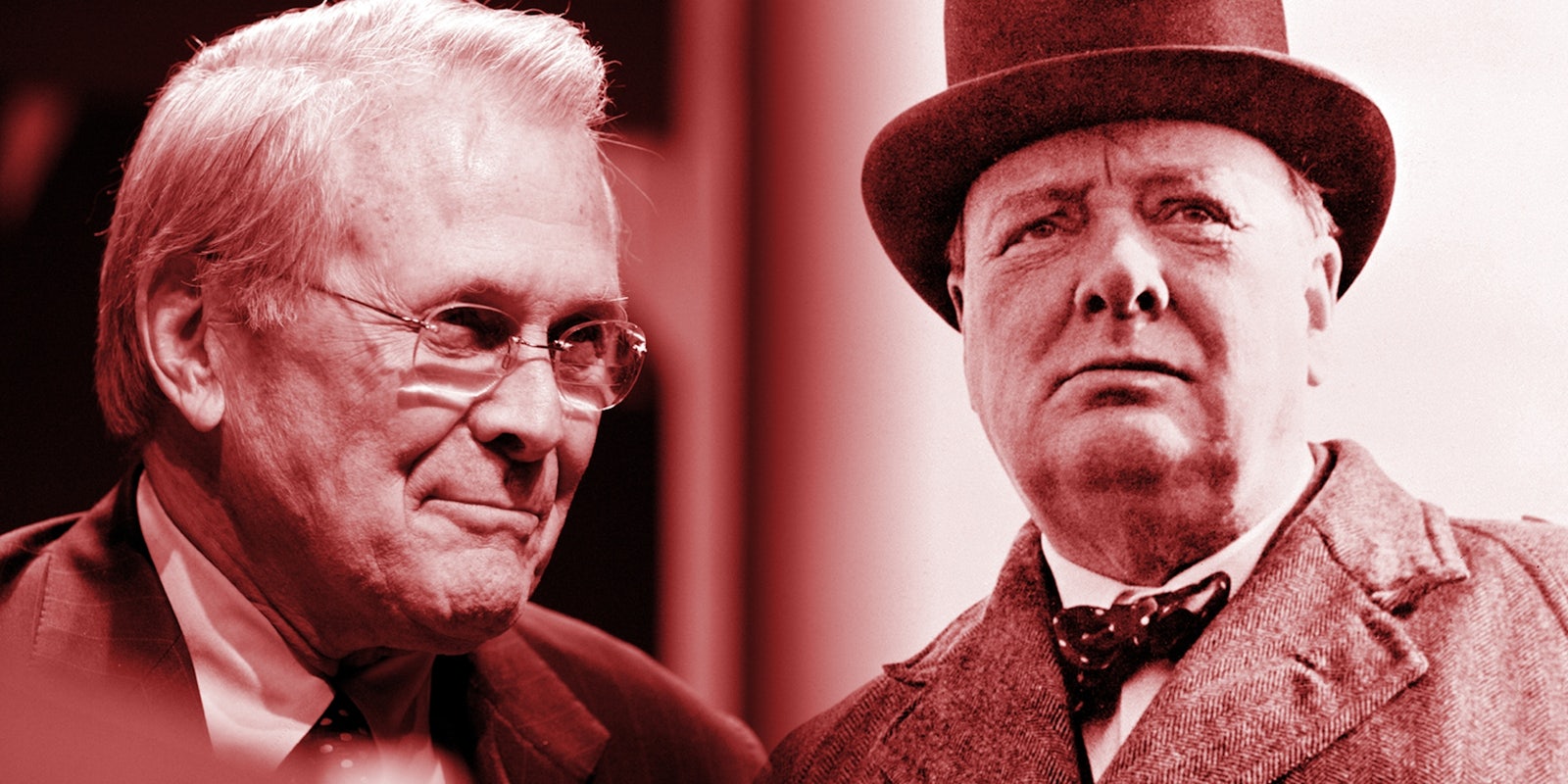Candy Crush. Farmville. And now, Churchill Solitaire.
At the ripe old age of 83, Donald Rumsfeld, the veteran of several Republican White Houses and one of the chief architects of the 2003 Iraq War, is diving feet first into the world of mobile gaming apps.
The game, called Churchill Solitaire, is a maddeningly complex version of the classic card game favored by legendary British Prime Minister Winston Churchill.
Like Solitaire, players attempt to sort a deck of cards by rank and suit in an allotted amount of either time or number of moves. But in Churchill’s version, players use two decks of cards instead of one. And the cards are sorted into eight piles instead of the original seven piles—a so-called “Devil’s Row” pile only adds to the complexity of game.
Rumsfeld’s app hits iPhones, Androids and tablets all over the world this week.
https://twitter.com/RumsfeldOffice/status/691401999951224832
The former defense secretary’s foray into the online gaming world is classic Rumsfeld—apparently using a Dictaphone to record “snowflake” memos to the team of developers and programmers working on the game.
But those who were on the receiving end of those infamous snowflakes inside the Pentagon, particularly during the Iraq War, may grimace at the irony of Rumsfeld delving into the world of video games.
The man who in the run up to the war championed, and later was forced to defend, the idea that modern warfare should be more akin to Call of Duty is now making video games.
The idea at the time, known within U.S. national security circles as force transformation—where technology would trump troop numbers—was seen as a supposed game changer.
Players use two decks of cards instead of one. And the cards are sorted into eight piles instead of the original seven piles—a so-called “Devil’s Row” pile only adds to the complexity of game.
No longer would the United States and its allies have to flood the battlefield with troops, putting thousands of American lives in harms way. According to the doctrine of Rumsfeld’s force transformation, wars could be won with a small number of actual soldiers, sailors, airmen and Marines backed by the best technology the U.S. military industrial complex could provide.
Autonomous surveillance aircraft. Smart bombs that could drop high explosives onto targets no bigger than a person’s home. Communications systems that could transmit enemy and friendly positions to U.S. forces in real time.
While U.S. forces were able to demonstrate with deadly clarity the significant advantages of battlefield technology in the 1991 invasion of Iraq, Rumsfeld’s transformation plan would usher in a new way of warfare for a different type of war.
This new way of warfare was put to the test in Baghdad and later places like Fallujah, Mahmudiya, Sadr City, Basra, and elsewhere across Iraq’s badlands in 2003. This battlefield experiment initially galled the Pentagon’s top brass tasked with running the war, knowing it would be their troops who would suffer that burden. And they did.
As the war dragged on in Iraq, it became clear Washington’s intelligence arsenal wasn’t as smart as Rumsfeld and his backers at the Pentagon expected. Smart bombs missed, killing civilians and adding fuel to the fire behind the growing insurgency, leading to the birth of counterinsurgency warfare, or COIN.
Iraqi insurgents and the growing contingent of al Qaeda fighters quickly figured out how to avoid American drones and surveillance by falling off the grid—travelling at night, forgoing email and cell phones for letter couriers and face-to-face meetings.
The insurgency also ushered in the antithesis of Rumsfeld’s transformation plan: the improvised explosive device.
The man who in the run up to the war championed, and later was forced to defend, the idea that modern warfare should be more akin to Call of Duty is now making video games.
So as Rumsfeld’s high-tech strategy fell victim to the low-tech tenacity of the Iraqi insurgency, the rancor among U.S. commanders and troops over being forced to fight with “the Army you have, not the one you might want” reached a fever pitch. Years after the final U.S. troops left Iraq in 2011, bringing an official end to Washington’s war in Iraq, the debate escalated over whether Rumsfeld’s force transformation experiment was truly worth it.
Rumsfeld’s strategy drew an increasing number of detractors on Capitol Hill—including a then-junior senator from Illinois and rising star in the Democratic party.
But in an ironic twist of history, it seems that President Barack Obama is now pulling a page out of Rumsfeld’s Iraq playbook in the growing battle with Islamic State.
One cannot help but feel a bit of deja vu when examining the Obama administration’s new battle plan to curb Islamic State’s rapid expansion across the Mideast: Small contingents of U.S. special operations forces armed with a fleet of unmanned attack and surveillance drones, backed up by the full weight of American airpower and a revamped cyberwarfare strategy.
Only time will tell whether Obama’s revamped ISIS strategy will be successful. However, as Donald Rumsfeld will tell you, in any war there will always be unknowns.
Carlo Munoz is a freelance foreign correspondent focusing on U.S. defense and national security policy, programs and operations. He was most recently a foreign correspondent with the Stars and Stripes, based in Kabul, Afghanistan. He also served as the national security Correspondent for BuzzFeed, The Hill and deputy editor at AOL Defense/Breaking Defense. Follow him on Twitter @NatSecCarlo.
Photo via Gage Skidmore/Flickr (CC BY SA 2.0) | Remix by Jason Reed


